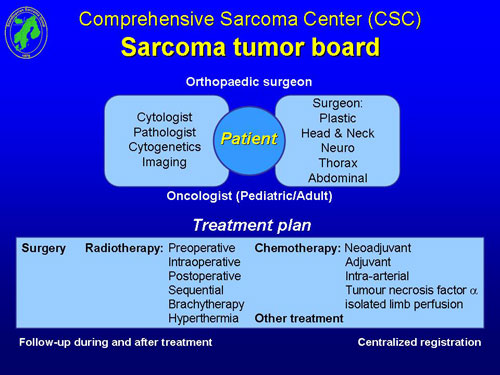|
|
- The Scandinavian Sarcoma Group (SSG) was constituted in 1979 and is composed of pathologists, radiologists, tumor biologists, orthopaedic and abdominal surgeons, gynecologists and oncologists (pediatric and adult) from the Nordic countries. In 2007 nurses and physioterapists established their own collaborative group. The aim of the SSG is to uphold and improve the quality of diagnostics, treatment and care of sarcoma patients by sharing information and education, clinical studies, research and patient registers. The SSG maintains a register of Bone and Soft Tissue Sarcoma Patients. SSG is financed by grants..
- The SSG is open to all specialists in the Nordic countries interested in sarcoma and has no membership fee.
- The SSG holds plenary meeting every other year and yearly subcommittee meeting. General Assembly is held at the plenary meeting. Board meetings occurs twice yearly. Notes of the meetings are kept by the SSG secretary and chairmen of the subcommittees.
- The SSG Board consists of 2 chairmen, 2 vice-chairmen,treasurer, secretary, vice-secretary and the respective chairmen of the 7 subcommittees (SSG Central Register, Imaging, Morphology/Tumor Biology, Orthopedic surgery, Visceral and retroperitoneal sarcoma, Oncology, Nurses and physiotherapists).
- The chairmen and secretaries are elected by the General Assembly for 5 years.
- The members of the subcommittees elect their own chairmen for 5 years.
- The SSG office is located in Lund and is working with the preparation of meetings, keeping the register of SSG members, and for the applications and details concerning grants.
- The publication policy for SSG follows the Vancouver protocol (International committee of Medical Journals Editors) for publication. See Publication and authorship rules for SSG.
|
|
